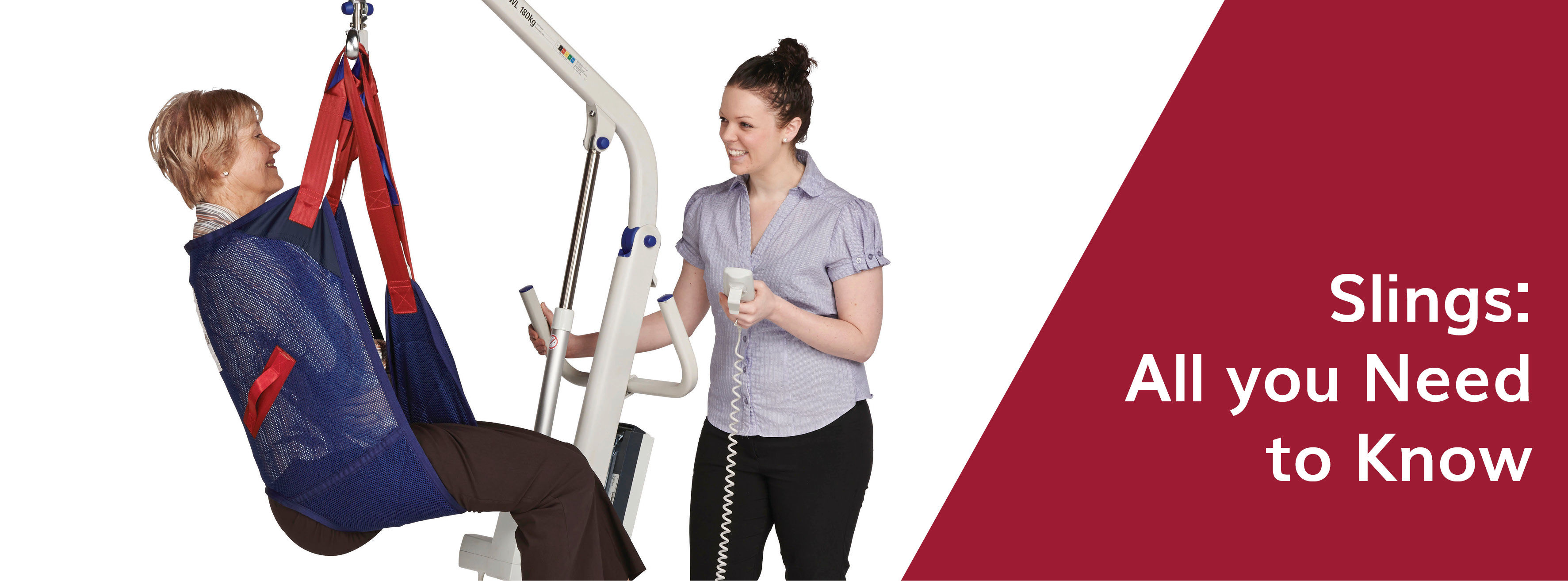At Access Rehabilitation Equipment, we commit to providing you and your loved ones solutions for life! Fitting your lifestyle, each aid and equipment is tailored to the unique challenges you are facing, so work with us to find the independence and mobility you want!

A sling and patient lift work together in order to create a system by which an immobile patient can be transferred safely and efficiently.
Lifters
There are various types and styles of lifters used for physically moving a patient, depending on the environment and the patient’s ability or purpose of the lift. They are typically battery or electrically powered. Different types of slings are utilised depending on the type of lifter and the individual needs of the patient.
Sling
The sling is used to cradle the patient’s body during transfer. It is usually attached to the yoke or arm of the lifter. The sling itself has no mechanical functionality, it is simply an interface between the mechanical component and the body of the patient. Slings are available in a range of different types, fabrics, shapes and sizes depending on the application and requirements for the patient.
Variations
Material
The material of a sling can vary depending on its primary use. Slings can be made from either a mesh or cloth material or in some instances a silk type fabric. Mesh slings are usually used in wet areas, such as the pool or bathroom, or other wet areas since this type of material will typically dry easily. Cloth slings are usually more comfortable for the patient and are generally used if there is little or no risk of soiling. Nowadays disposable slings are available to assist with infection control. These are designed for short term use mainly in hospitals.
Size
Slings and lifters range in sizes and capacity from extra small to XX large. These sizes are based on both weight and physical requirements. Custom sizes are also an option for those with individualized needs that are not met by stock sizes or ready-made size options.
Types of Lifters
Ceiling Hoist
A ceiling hoist system includes rails attached to the ceiling that can cover either one specific pathway or may reach to every part of a space or a room. The lifter operates by moving along these rails to transfer the patient from one place to another. Typically the lift and lower function is battery or electrically powered with the movement along the rail either manual or powered. Sophisticated systems can be powered up to six ways, up - down, forward - reverse, and multi rails axis. A ceiling hoist rail system can be configured to cover multiple rooms, for instance a bedroom and bath in separate rooms or can be designed to suit a specific layout.
General Purpose Floor Lifter
General Purpose lifters typically have a spreader bar or yoke setup to which slings can be attached with loops or straps. Some lifters have a pivot frame attachment where the slings are connected with a keyhole buckle fastening attachment. The purpose of the pivot frame is to enable the carer to adjust the position of the patient from a lying to sitting or vice versa whilst they are suspended in the frame. This is particularly useful for positioning larger or bariatric clients. The pivot frame can be operated either manually or powered. This type of lifter is typically electrically powered by a rechargeable battery and usually will have electric adjustable legs to enable close access to larger chairs.
Standing Lifter
Standing lifters are particularly useful to assist a patient from a seated to standing position. The lifter is angled in such a way that when the patient is raised to a standing position, they are protected against falling forward and are held upright by the sling. This type of lifter is typically electrically powered by a rechargeable battery and will usually have electric adjustable legs to enable close access to larger chairs.
Types of Slings
General Purpose Sling
General Purpose Slings are designed for patients who do not require a lot of back support while the patient is in a seated position. These are very simple to fit for individual patients.
Full Body Sling or Head Support Sling
This type of sling allows for transfer of patients while in a reclined seating position. This type of sling provides maximum support for the entire body including the neck and head.
Standing Sling
A standing sling is designed to assist a patient with maneuvering from a seated position to a relaxed standing position. It is attached to and used only with a standing lifter. This sling (and lifter combination) should only be used if the patient can weight bare to some extent as it relies on a certain amount of input from the patient for safe use.
Toilet Sling
Toilet slings are specifically designed to assist carers to position over a toilet or commode chair. This sling can also be utilized to assist carers while dressing or undressing patients. With these types of slings, there is usually a larger opening or aperture in the bottom or buttock area. This slings are usually made of mesh for easier cleaning and drying.
Customisation
Slings and lifts can be manufactured with alterations or additions depending on the needs of the individual patients. Some slings come with additional head support or support for a specific limb. Others can be manufactured with cut outs or holes in order to accommodate particular unique body positions.
Safety Considerations
Wear and Tear
It is extremely important to follow the manufacturer’s instructions for expiration dates on slings. It is also important to regularly investigate slings for any signs of wear and tear. If the sling is past its intended life span or shows signs of wear and tear, it must be removed from service immediately to ensure the safety of its user.
Weight Limits
All slings and lifters have maximum weight limits which must be recognized and adhered to. If the sling and lifter weight limits do not match, the lower weight limit is to be used as the maximum. It is important that this weight limit is never exceeded in order to prevent any possibility of an incident or injury to patient or carer.



 Providing solutions for life
Providing solutions for life







